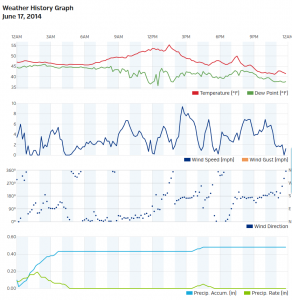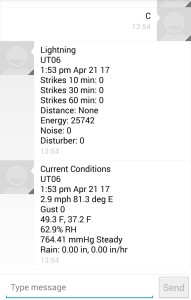All tools are designed with particular constraints in mind. Engineers must balance design priorities such as precision, cost, ease-of-use, application needs, material characteristics, operating environment, manufacturability, serviceability, and so forth. Compact cars and 4×4 trucks are optimized for their intended application and within their own unique design constraints.
A plastic, $40 weather instrument may be just as effective for a specific application as one that costs $25,000.
Professional Weather Station
It isn’t hard to find consumer-grade equipment with the “Professional” moniker. Ink is cheap.
So, what is a “Professional Weather Station?” Anyone that does the job it is intended to do.
Precision Weather Station
Weather station equipment, like any instrument, is only as good as the installation. Research weather stations can produce junk measurements just as effectively as a grocery store instrument. More decimal places does not make better data.
A number of years ago I worked as a camera repair technician. Occasionally, we would be asked to repair or comment on an “exclusive” camera. These, typically German, cameras claimed exotic capabilities or precision construction and were always owned by amateurs.
In contrast, I worked with several professionals that used low-end equipment because they understood where and how a good image was created and the variables involved.
The principle questions affecting the need for precision and accuracy are determined by the application.
- What measurement change will affect actionable decisions?
- Are comparative measurements between stations involved?
- If comparative measurements are used, can installation and equipment differences be controlled and are differences understood?
For example, aviation applications do not make flight changes if there is a 1 degree or 2 degree change in the wind direction. Wind is reported using 2 min or 10 min averages and presented in 10 degree increments. Consequently, selecting a high-end instruments that provide 0.02 degree resolution may be misguided if this is the principle requirement.
In commercial or industrial weather station applications, wind, temperature, humidity, or other measurements are only one input to management decisions. An increase in air temperature of 5 degrees may increase the risk of worker heat stress, but risks inherent to worker extraction, duration of exposure, re-initiation, task completion, process control, and other factors must also be considered along with available mitigation measures.
“Does little Johnny need to wear a coat this morning?” does not require 0.01°C accuracy.
Variability of Physical Measurements
Related to precision, users must also recognize the limitations of physical measurements. Turbulent fluids, such as air, open water, and wind have no absolute depth, temperature, or flow rate for the volume of the body. In these cases averages and other statistical or empirical measures may be used to provide a quantitative approximation. Two matched temperature sensors placed several inches apart will read differently.
Air temperature in a mining tunnel may vary by 10 degrees F or more across the tunnel area. Evaporative cooling from seepage will cool one area while radiant heat from a steam line will heat another. Temperature gradients from floor to ceiling may also be significant. If a single point measurement is used, decision-makers must understand the point at which the measurement is taken.

Dyacon Station on Weather Underground
A more pedestrian weather station example would be the effect of nearby structures on wind patterns, temperature, and humidity. The temperature and wind from a roof-top weather station will be dramatically different from one located in an open field nearby.
Data accessibility
Even the best weather station that is properly installed and collects precision data is useless if the data sits in a log file and is not accessible. There are many research weather stations, often funded through government money, that are merely employment vehicles for those that maintain them. Many gigabytes of data is sitting in databases unused.

Weather Station Report – Cell Phone Screen
Getting the data to the end user is critical. Data delivered by cell phone text message, mobile app, or webpage may help return value on the purchase.
Direct connection to automation equipment may also be required. In some cases this may require additional modules, adapters, or accessories.
Know Your Equipment
Collected data may also not be useful if the data users do not know and understand the nature of the equipment behind the measurements, how or where it is installed, how it is maintained, and how the data is delivered.
Some sensors may have limitations that should be considered. A lightning detector may have range, latency, or detection efficiency characteristics that need to be understood by users.
Additionally, comparative measurements from one station to another may be misleading or useless if these issues are not understood.
Total Cost of Ownership
Upfront cost is only one consideration when purchasing equipment. While the purchase budget may be significant, installation cost, data accessibility, system maintenance, and repairs will take a toll.
Some equipment must be installed and maintained by exclusive dealers. This may or may not be appropriate for your application. If current staff will be used, sourcing equipment that is within the skill-level of available technicians is critical.
Equipment that remains unrepaired because no one knows how it works, jeopardizes the investment and operations that depend on it.
A WiFi-connected weather station may lower reoccurring wireless costs when compared to a cell phone station. However, equipment value may be compromised due to limitations on equipment placement options, internal cost or delay in IT support, and interruptions in data accessibility. All of these may add to the “cost” of a weather station.
Summary
When selecting “The Best Weather Station,” keep the purpose in mind. This is typically much more important than comparing sensor specifications.
Consider ancillary costs when making an equipment selection. Installation and maintenance are significant additions.
While you generally get what you pay for, the best weather station is one that meets your cost, installation, and application needs.
We keep a (growing) list of weather station and instrument manufacturers that we think are significant players in the market, from low-end to “research-grade.” If you would like a copy of the list, please let us know. While not exhaustive, it may help you become familiar with the range of options available.
Contact us if you would like some suggestions. We may not be a fit for your application, but we would love to learn about your needs and point you in the right direction.
Eugene
Product Engineer
